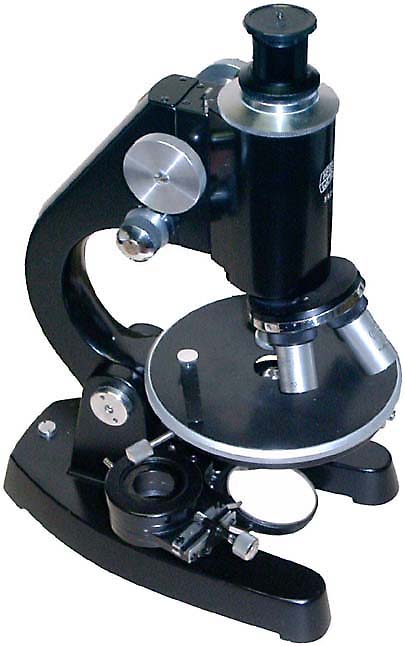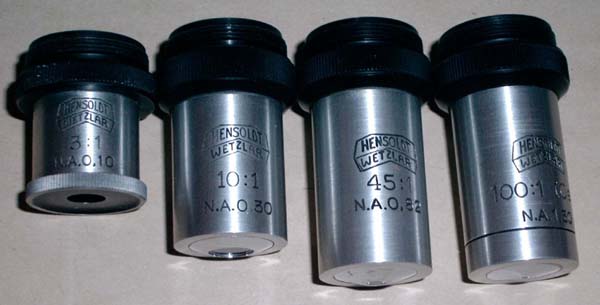
I would like any information that anyone may have on the Hensoldt (Wetzlar) microscope that I recently purchased. Its serial number is 35283. Digital photographs of the microscope and its optics are shown below.
The following photograph shows the microscope with the filter tray and iris swung out from under the stage. Note the offset control for the iris and filter tray. The focus control for the condenser is not in view being on the far side of the microscope.
The dimensions are: Base width: 140 mm. Base Depth: 210mm. Height: about 300mm (varies because the tube is moveable).

The following photograph shows the oculars in their (original) wooden holder.

The four objectives are shown in this picture below.



|
This is the box in which the microscope came. It has a very sturdy metal handle on the top. Not shown anywhere but the scope's serial number is stamped on the top of the door. The wear and tear is obvious at the foot of the box where the scope slides in. Box dimensions: Width: 210mm. Depth: 254mm. Height: 375mm (excludes handle). |
The open box showing the scope. On the upper left hand side is the holder for the occulars; the upper right hand side is the holder for the cannisters for the objectives; and, just under this is the accessory box holding its goodies. Click image to view a larger version. |
|
|
Click image to view a larger version. |
|
Click image to view a larger version. |
|
I am particularly interested in its history, date of manufacture, manuals (this is really wishful thinking) or any other information that the readers of Micscape may have on this instrument. My internet searches have turned up very little except that Hensoldt was taken over by Zeiss over a period of some years. I found nothing on the Zeiss site nor have I found any information on this microscope in any of the vintage or historical microscope sites I visited.
The microscope is in extremely good condition and provides exceptionally clear images. The depth of field is very shallow, especially at the higher powers, and the image appears very flat nearly up to the edges of the visible field.
The unit is in its original, very sturdy, wooden box which appears to be oak. The unit came with some of its original contents including dissecting needles, two glass filters (clear blue and frosted white), a stage micrometer, immersion oil, a small vial of Canada Balsam, a few 50x50mm slides and some 18x18mm slide covers.
The microscope has four objectives all of which bear the Hensoldt (Wetzlar) logo along with the following powers and numerical apertures respectively: 3:1, NA 0,10; 10:1, NA 0,30; 45:1, NA 0,82; and, 100:1 (Oel), NA 1,30. The 100x is an oil immersion objective. I suspect the 3x objective is designed for viewing large objects, probably without a cover slip, and is intended to be used in place of a dissecting microscope for field work. The original metal canisters for these objectives are in a separate wooden frame similar to the one shown housing the oculars.
The condenser is marked with an NA of 1,20, is infinity corrected, focused by a rack and pinion system and has a control to offset the iris and filter tray. The filter tray takes 33mm filters or slightly smaller as I measure a diameter of 32,9mm. The microscope has a 360 degree rotating stage with two mechanical stage controls for positioning the slide. The stage controls are about 120 degrees apart. I estimate the extent of movement of the mechanical stage controls as approximately 5mm in any direction from the centre position. The microscope has a double sided mirror with one side flat and the other concave.
There are 5 oculars all bearing the Hensoldt (Wetzlar) logo: 4x (with a graticule); 5x; 8x; 12x and, 17x. Both the 12x and 17x are compensated. The oculars are of the Huygenian type. The photograph of the microscope shows the unit with a Nikon cap covering the eyepiece.
As a bit of background, I was given my first microscope over 50 years ago by my parents and I was not parted from it for more than 20 years. Wherever I went, it went. Unfortunately, my microscope, microscopy books and all slides were lost as a result of an unfortunate incident about 30 years ago. I then became involved in my family and career (electronics and computers) and put my interest aside 'for a short while'.
Now that I am about to retire, however, I intend picking up where I left off and start learning how to use the microscope all over again. With Micscape as my guide and its many authors acting as my mentors, I cannot go wrong.
When I feel a bit more confident in my abilities, I should like to make contributions to Micscape. Thus far, I have managed to take some reasonably decent microphotographs but am still unable to identify most of what I see or capture on digital 'film'. My main interest is in freshwater organisms although it is not limited to this alone.
In addition to the Hensoldt, I have a student compound microscope, also monocular, that I purchased second-hand a few years ago. This microscope is definitely not in the same league as the Hensoldt but is easier to use with respect to taking photomicrographs.
Thank you for your time and assistance in this matter.
Comments to the author Ed Murray are welcomed.
(Editor's note) Related
Micscape links:
Martin Mach's article
'The minimum
microscope: The Hensoldt Tami' describes
and illustrates one of the small microscope models which this company made.
Please report any Web problems or offer general comments to the Micscape Editor.
Micscape is the on-line monthly magazine of the Microscopy UK web site at Microscopy-UK